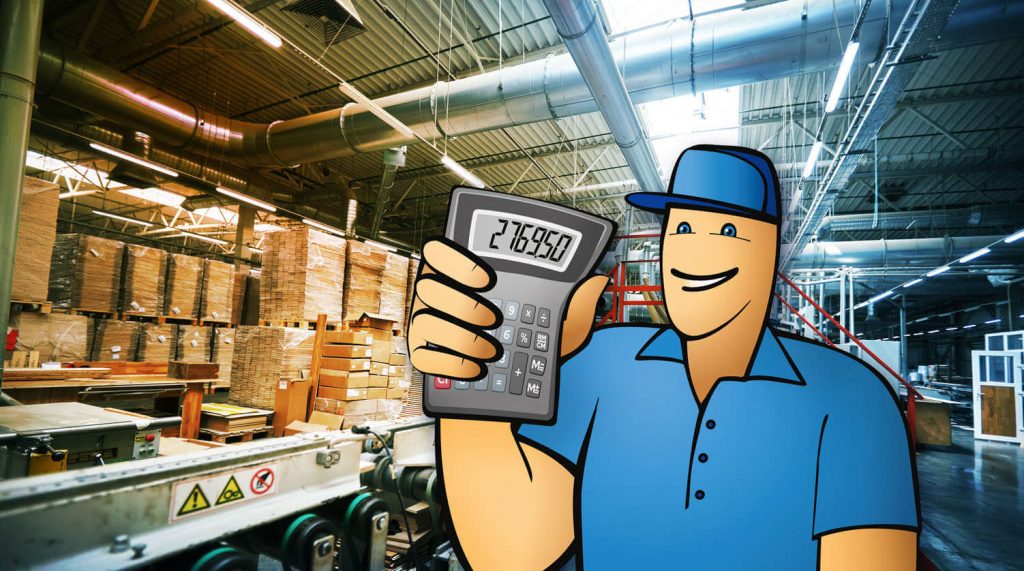Total Manufacturing Cost – What is it and How to Calculate it?
Total manufacturing cost is an essential metric for understanding the profitability of a business. It can be used to adjust the selling price of your products, identify and cut expenses, and calculate other key metrics like the Cost of Goods Manufactured. In this post, we explore total manufacturing cost and its utility to manufacturers.

You can also listen to this article:
What is Total Manufacturing Cost?
Total manufacturing cost is a financial metric that expresses the total amount of funds spent on all production activities during a financial period. In plain terms, it is the total cost a company spends on manufacturing its products. As such, calculating TMC precisely is invaluable for anyone looking to gain more insight into their manufacturing cost accounting fundamentals.
Keeping a close tab on this metric carries a lot of utility. Managers or investors can compare it to total revenue in the balance sheet to get a quick overview of the company’s profitability and adjust profit margins. It is also useful for adjusting the selling price of products. Additionally, TMC can help uncover inefficiencies in the supply chain, shop floor, and inventory levels.
While quite basic on paper, gathering precise information on all these constituents can be a challenge in real life. Since the total manufacturing cost is an essential metric for understanding the productivity and profitability of a business, it really pays to get it right the first time.
Read more about Calculating the Selling Price of Your Products.
How to Calculate Total Manufacturing Cost?
Total manufacturing cost consists of three key business costs: direct material costs, direct labor costs, and manufacturing overhead costs.
The total manufacturing cost formula is a simple equation in which all of these are added together.
Total Manufacturing Cost = Direct Materials + Direct Labor + Manufacturing Overhead
Gaining accurate insight into these cost articles can be easier said than done, however. Next, let’s look at each of these costs in a bit more depth.
Direct material costs
Direct materials are the actual physical materials needed in order to manufacture products. Direct materials only constitute items that are used in significant, measurable quantities in manufacturing, i.e. the materials included in the bill of materials of a product.
Conversely, indirect materials are generally used in many types of products in insignificant quantities per unit. These are not included in direct materials and fall into the manufacturing overhead. For example, for a furniture manufacturer, timber, paddings, and textile are the direct materials used in production, while glue or sandpaper are indirect materials.
Direct material costs can be found by adding the cost of purchased raw materials to their beginning inventory and then subtracting their ending inventory.
Direct Materials used = beginning raw materials inventory + cost of raw materials purchased – ending raw materials inventory
It’s useful to note that the same raw material might also be used as both direct and indirect material pools. For example, for a soda producer, water is used as a direct material, forming the body of the drink. However, water could also be used as an indirect material to wash the bottles or equipment. It’s necessary to keep these types of consumption separate for accounting purposes.
The direct material cost should never be calculated by multiplying the number of final products with the material quantities from their BOMs. Work in process inventory, waste, and scrap all need to be accounted for as well. This is why raw material inventory and material purchases should only be used to calculate direct material costs.
Direct labor costs
Much like with direct materials, direct labor costs constitute all labor that goes toward converting materials into finished goods. In other words, the direct labor costs that go into the total manufacturing cost calculation are only made up of staff directly involved in the production part of the business. Think line workers, craftspeople, machine operators, etc.
Staff not handling the production of goods, such as management, accounting, maintenance, cleaning staff, etc. are not considered direct labor. These expenses constitute indirect costs, at least from the perspective of the manufacturing process, and are allocated as overheads.
Do note, however, that direct labor costs generally do include retirement funds, holiday pays, payroll taxes, and any additional fees that direct laborers bring with them. Some companies may even decide to include costs related to training the production staff in direct labor costs.
Manufacturing overhead costs
Manufacturing overhead costs a.k.a indirect manufacturing costs make up all expenses related to manufacturing that are not directly related to manufacturing goods. Here is a list of things that altogether constitute total manufacturing overhead:
- Production facility rent or mortgage;
- production facility insurance and utilities like electricity and water;
- indirect supplies and materials used in production;
- indirect labor costs related to manufacturing such as production supervisors and managers, quality assurance personnel, factory cleaning staff, etc.;
- maintenance and repair costs;
- equipment and facility depreciation.
Manufacturing overhead does not include costs unrelated to the manufacturing process like administration wages, sales and marketing expenses, office rent, etc. These are general costs of doing business and are calculated separately as overhead expenses for the manufacturing business.
It is more difficult to precisely assign some manufacturing overheads to the total manufacturing cost. These are overheads based on asset value like utilities or rent. Whereas direct material and labor are set quantities that can be divided by the number of units produced or the time it took to produce them, these types of costs need to be apportioned to finished goods uniformly.
Read more about Applied Overhead vs. Actual Overhead.
Total Manufacturing Cost vs. COGM vs. COGS
Total manufacturing cost is a useful metric in its own right, as we will see shortly. However, it also informs another critically important KPI, namely, the Cost of Goods Manufactured (COGM), which in turn is necessary to calculate the equally important Cost of Goods Sold (COGS). Here’s how the three are interrelated.
While the total manufacturing cost shows how much money was spent on all production activities, COGM details the costs related only to the production of those goods that were finished during a given period. This means that unfinished products that were transferred into Work in Process (WIP) inventory are left out. If all production was finished at the end of the period, however, TMC and COGM would be equal.
This is the formula for finding the cost of goods manufactured:
COGM = Beginning WIP Inventory + Total Manufacturing Cost – Ending WIP Inventory
The Cost of Goods Sold or COGS is the cost of only the finished products that were sold during a given period. It’s one of the most important rows on the income statement and enables finding a company’s gross profit by deducting its value from revenue. For manufacturers, calculating COGS is possible only after finding the value of COGM. If all of the goods finished during a period were also sold, COGS and COGM would equal each other.
This is the cost of goods sold formula:
COGS = Beginning Finished Goods Inventory + COGM – Ending Finished Goods Inventory
Read more about the Cost of Goods Manufactured (COGM) and the Cost of Goods Sold (COGS).
The Utility of Total Manufacturing Cost
Taking a look at the total manufacturing cost is insightful for making your manufacturing company more cost-effective. While it is predominantly an accounting term, its utility can go far beyond balancing the books. Namely, TMC can shed light on areas in the production process that need optimization.
Here is a list of insights that keeping a close eye on the total manufacturing cost can bring:
- Comparing TMC with total revenue offers quick insight into the company’s profitability. If the profits are lower than expected, you can either review the selling price of your products or find areas for cutting costs.
- Analyzing total manufacturing cost shows you which expenses were higher than expected. For example, it offers visibility into overhead cost changes over time or helps to easily spot if suppliers have upped their pricing.
- Keeping a close eye on expenditure means ripe opportunities for reducing waste and also increasing efficiency. In this regard, TMC can aid in raising overall manufacturing efficiency and help spot opportunities for production optimization.
- As already mentioned, total manufacturing cost can be used to calculate the Cost of Goods Manufactured and the Cost of Goods Sold, both essential aspects of manufacturing accounting.
Total Manufacturing Cost in an MRP system
Along with many other manufacturing accounting metrics, total manufacturing costs can easily be tracked in an MRP/ERP system. Using this kind of software with a built-in manufacturing accounting system frees up managers’ time for activities that help actually grow the company.
Since MRP systems use a perpetual inventory system, financial metrics are calculated automatically based on real-world input data. This makes them much more precise than approximating values manually and also provides a good litmus test for comparing the measured KPIs against their theoretical values.
In periodic inventory systems, where things are done manually or using spreadsheets, regular stocktakes need to be performed and material invoices summed up to get the numbers right. ERP/MRP software, however, continuously calculates the direct material cost from purchases as well as the direct labor costs by summing up reported work hours of manufacturing orders.
In addition, whereas in manual mode, manufacturing overhead costs only become clear after a financial period is over, ERP/MRP software can be used to apply the manufacturing overhead costs to products according to preset or dynamic rates. This gives a better insight into cost and profit in real-time, helping to set more informed pricing.
Robust MRP systems can track production costs both per period, per project, or per product, making them suitable for both job shops as well as make-to-stock manufacturers.
Key takeaways
- Total manufacturing cost is the total sum that has been spent on production activities during one financial period. As such, it is an essential metric for understanding the productivity and profitability of a business.
- TMC consists of three key parts: direct material costs, direct labor costs, and manufacturing overhead costs.
- Direct material costs are the costs of materials that can be quantified per product, i.e. materials that are part of the BOM.
- Direct labor costs are costs related to the salaries of employees directly responsible for production, i.e. line workers, craftspeople, machine operators, etc.
- Manufacturing overheads are indirect costs related to the production of goods. This includes production facility rent/mortgage, utilities, indirect materials used in production, indirect labor costs related to production, maintenance costs, depreciation of equipment, etc. Manufacturing overhead does not include administration wages, sales and marketing expenses, office rent, or other staff salaries.
- The total manufacturing cost is used to calculate the Cost of Goods Manufactured (COGM) and the Cost of Goods Sold (COGS) and can provide invaluable insights into the efficiency and financial health of a manufacturing business.
Frequently Asked Questions
Total manufacturing cost is an accounting metric that sums up all of the costs that go into manufacturing a company’s products. These include direct material and labor costs, as well as manufacturing overheads.
The formula for calculating total manufacturing cost is quite simple. Total manufacturing cost = direct materials + direct labor + manufacturing overhead.
The three basic types of manufacturing costs are direct materials, direct labor, and manufacturing overhead. Direct materials are the physical raw materials that products are made out of. Direct labor is all of the wages and other costs of personnel directly associated with manufacturing the products like machine operators and shop floor workers. Manufacturing overhead costs are all the indirect expenses without which manufacturing would be impossible, such as factory utilities and rent, machine upkeep, indirect materials, etc.
While the Total Manufacturing Cost shows how much money was spent on all production activities, another metric – the cost of goods manufactured or COGM details the costs related only to the production of those goods that were finished during the period. This means that unfinished products that were transferred into Work in Process (WIP) inventory are left out of the sum.
You may also like: What Is Production Capacity and How to Calculate It?




